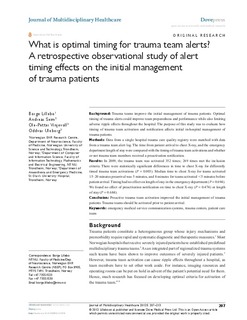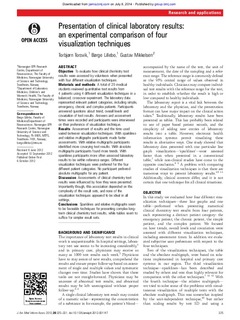| dc.contributor.author | Lillebo, Børge | nb_NO |
| dc.date.accessioned | 2014-12-19T14:22:00Z | |
| dc.date.available | 2014-12-19T14:22:00Z | |
| dc.date.created | 2014-07-08 | nb_NO |
| dc.date.issued | 2014 | nb_NO |
| dc.identifier | 733228 | nb_NO |
| dc.identifier.isbn | 978-82-326-0190-5 (printed ver.) | nb_NO |
| dc.identifier.isbn | 978-82-326-0191-2 (electronic ver.) | nb_NO |
| dc.identifier.uri | http://hdl.handle.net/11250/264254 | |
| dc.description.abstract | BACKGROUND
Patient care and management in hospitals is more difficult than ever before. Not only must clinicians perceive and interpret vast amounts of medical information related to single patient management, they are also expected to coordinate their own and their patients’ activities to achieve most health benefit per value spent. The overall objective of this thesis was to explore, develop and evaluate technology that may support perception and interpretation of information related to individual patient management and care coordination.
METHODS
The research has been conducted within the context of perioperative care, including operating theatres, post-anaesthesia care units, trauma team management of emergency patients and assessment of individual patients’ laboratory test results. Field work with focused interviews and in-depth interviews with perioperative staff were carried out to understand what information supports perioperative staff members in managing their own and their patients’ activities, and how that information is perceived. Patient status overviews were iteratively developed and evaluated through simulated ward work scenarios to understand what information supports surgical ward nurses in managing perioperative care, and how that information can be presented on a digital whiteboard without compromising patient privacy. An observational retrospective cohort study was conducted to evaluate the importance of projected perception of a care activity on patient management. Finally, we did a balanced, crossover experiment with medical students as participants to explore the effects of four laboratory test result presentation formats on the quality and efficiency of perception and interpretation of such results.
RESULTS
Perioperative activities unfold unpredictably, and perioperative care management relies heavily on ad hoc communication. Although schedules are perceived as important collaborative artefacts, they provide limited support for timely execution of individual work. A patient management status board including a continuously updated list of recent care events as well as a list of estimated onset of expected future events was welcomed by ward nurses. Such a status board was expected to facilitate perception and improve awareness on new care information as well as reduce the workload of coordinating care. Continuously updated estimated projections of expected future events were considered to be an effective means of interdepartmental communication. There was a significant association between the efficiency of the initial intrahospital trauma patient management and the time from trauma team activation until patient arrival (i.e. the amount of temporal projection). The descriptive data suggested that 10-20 minutes pre-arrival activation of the team was optimal timing. Pre-activation trauma team notification was not associated with the efficiency of patient management. The formats with which laboratory results were presented influenced both speed and quality of the assessment. Participants preferred different presentation formats for different kinds of patients. A table sufficed for sets of laboratory results consisting of few blood samples, but line graph visualisations seemed favourable for sets of laboratory results consisting of many samples. No single presentation format was superior in all respects.
CONCLUSION
Presenting proper information at the right place and right time is important, and for some information presentation format also may matter. Providing clinicians with timely updates on care activities and estimated onset of expected future events seems to be a fruitful technological solution to support coordination of hospital services. Furthermore, information visualisation has a potential of enhancing the perceptual and cognitive skills of clinicians – influencing the clinical assessment of patient data both qualitatively and quantitatively. | nb_NO |
| dc.language | eng | nb_NO |
| dc.publisher | Norges teknisk-naturvitenskapelige universitet, Det medisinske fakultet, Institutt for nevromedisin | nb_NO |
| dc.relation.ispartofseries | Doktoravhandlinger ved NTNU, 1503-8181; 2014:134 | nb_NO |
| dc.relation.haspart | Lillebo, Børge; Faxvaag, A.. Continuous Coordination in Perioperative Work. . | nb_NO |
| dc.relation.haspart | Gjære, Erlend Andreas; Lillebo, Børge. Designing privacy-friendly digital whiteboards for mediation of clinical progress.. BMC medical informatics and decision making. (ISSN 1472-6947). 14(1): 27, 2014. <a href='http://dx.doi.org/10.1186/1472-6947-14-27'>10.1186/1472-6947-14-27</a>. <a href='http://www.ncbi.nlm.nih.gov/pubmed/24708868'>24708868</a>. | nb_NO |
| dc.relation.haspart | Lillebo, Børge; Seim, Andreas; Vinjevoll, Ole-Petter; Uleberg, Oddvar. What is optimal timing for trauma team alerts? A retrospective observational study of alert timing effects on the initial management of trauma patients.. Journal of multidisciplinary healthcare. (ISSN 1178-2390). 5: 207-13, 2012. <a href='http://dx.doi.org/10.2147/JMDH.S33740'>10.2147/JMDH.S33740</a>. <a href='http://www.ncbi.nlm.nih.gov/pubmed/22973111'>22973111</a>. | nb_NO |
| dc.relation.haspart | Torsvik, Torbjørn; Lillebo, Børge; Mikkelsen, Gustav. Presentation of clinical laboratory results. JAMIA Journal of the American Medical Informatics Association. (ISSN 1067-5027). 20(2): 325-31, 2013. <a href='http://dx.doi.org/10.1136/amiajnl-2012-001147'>10.1136/amiajnl-2012-001147</a>. <a href='http://www.ncbi.nlm.nih.gov/pubmed/23043123'>23043123</a>. | nb_NO |
| dc.title | Supporting Clinical Perception: A multi-method approach to how technology may support clinical perception | nb_NO |
| dc.type | Doctoral thesis | nb_NO |
| dc.contributor.department | Norges teknisk-naturvitenskapelige universitet, Det medisinske fakultet, Institutt for nevromedisin | nb_NO |
| dc.description.degree | PhD i medisinsk teknologi | nb_NO |
| dc.description.degree | PhD in Medical Technology | en_GB |



